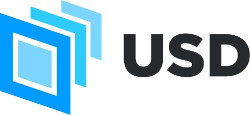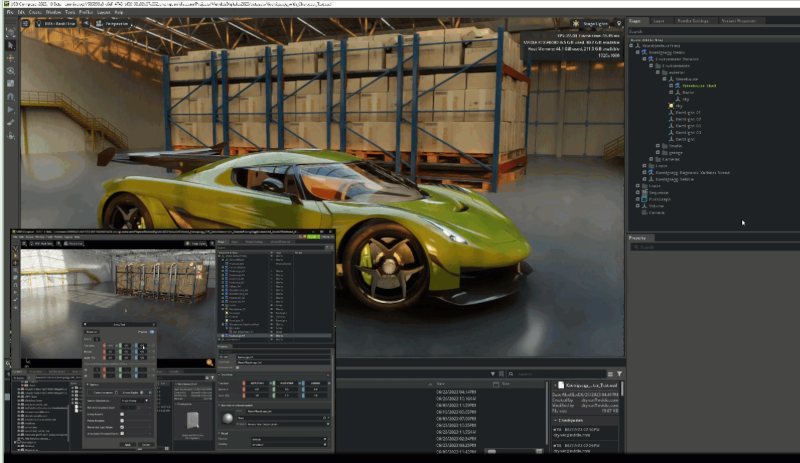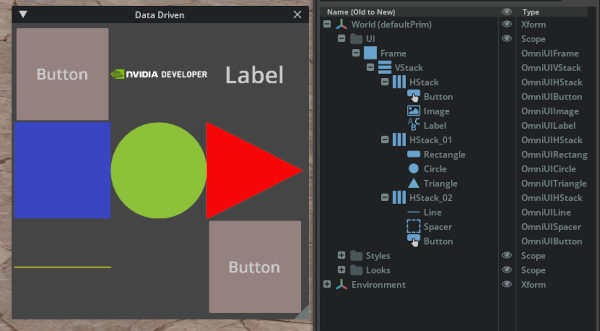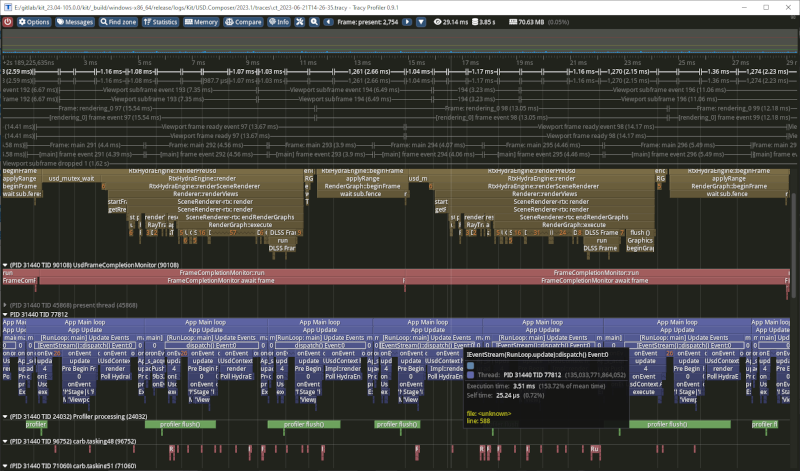Release Notes
Code 2023.1.1 - Release Highlights
Release Date: August 2023
Code 2023.1.1 marks the first release of the Omniverse Foundation Apps. Omniverse is a platform built to allow you to easily extend the Kit platform and build any experience you desire. The Foundation applications are starting points based on specific workflows to provide a great starting point into the Omniverse Ecosystem. In the Foundation Apps you can expect tested and extendable Extensions that we’ll continue to improve, document, and allow for easy entry points to create your own custom Omniverse application.
Kit Major Dependency Updates
Upgrade to USD 22.11

The USD 22.11 upgrade includes Asset Resolution 2.0 (Ar 2.0) support. Ar 2.0 makes it easier to support multiple asset systems: one resolver can handle a local filesystem, another can handle http, and so on.
See:
OpenUSD Changelog (and back as far as 19.11)
Upgrade to Python 3.10

The Python 3.10 upgrade from 3.7 brings a large number of features and general improvements as well as plethora of security-related fixes. See:
For more details and help on updating extensions etc see our Migration guide
Welcome Window
Code includes a new extension omni.kit.welcome.window that is designed to pop up when you start your application. It is user-friendly and highly adaptable. Users can easily access recent files, samples, and learning resources, while developers can customize the experience by adding additional features that are most relevant to their users needs.
For more details, see the relevant Developer docs
On-Demand Extension Loading - omni.app.setup
Apps built on Kit 105.0+ allows extension to be loaded on demand. While menus continue to present all available features, an extension providing functionality is only initialized upon first use. This optimization greatly reduces startup time and eliminates unnecessary delays.
This approach is also extended to Layouts - predefined Layouts can be defined and their extensions loaded only when the layout is chosen (See e.g “Viewport”, “Documentation”, “Browsers” under the new Layout menu in the Code main app menu bar)
For more details, see the relevant Developer docs
Public Extension Registry
Code users can now download new extensions or update existing ones from a public extension registry which will be updated on a regular basis - so Code itself does not need to be released as often, and can contain a slimmed down set of extensions.
Live Edit Workflows - omni.kit.widget.live

Collaborators can now get into a Live session faster. The default action now loads a collaborator directly into the default session. Collaborators can also share omniverse links directly to the file and session they are in, making it easy to have another collaborator join.
In addition to this, collaborators also now have a better sense of spatial awareness with one another while live in a stage. Each user has an assigned accent color that builds an association between their user icon, their selection outlines in the viewport, and offscreen pointers.
Users can iterate on prim directly live. A Live Prim takes in a standard Live Session directly onto Reference or Payload Prim as receive only.
For more details, see Omni Live
No Code UI - omni.no_code_ui.bundle

Creating compelling user interfaces is already possible for Python developers but Omniverse seeks to democratize authoring by providing no-code solutions. We do this by providing an Action Graph that allows anyone to create behaviors - and now we’re adding the ability to create user interfaces as well.
With Kit 105 based apps like this Code release, users can create layouts and widgets using the same workflow used for stage composition. Combining these widgets with Action Graph, interactable uniquely styled experiences like configurators and design review tools can be authored without requiring Python programming.
For more details, see No Code UI
Metrics Assembler - omni.usd.metrics.assembler
The Metrics Assembler Extension is responsible for fixing scaling issues in USD stages. It ensures that when one USD file is composed into another active stage, its Meter Per Unit (MPU) scale, up-axis orientation and any densities assigned via the UsdPhysics scheme (KPGU or kilograms per unit) are adjusted so that they correctly match the MPU and values within the active stage. The Extension runs in the background in your Kit app and detects any user drag-and-drop of USD files into an active stage.
For more details, see Metrics Assembler
SimReady Explorer - omni.simready.explorer

SimReady Assets are the building blocks of industrial virtual worlds. They are built on top of the USD platform and have accurate physical properties, behaviors, and connected data streams. They are comprised of multiple files such as USD layers, material description files (.mdl), textures, thumbnails, etc.
We are providing assets that are built with proper scale, physics, and materials to work directly in simulation. This first release comes packed with over 1,000 assets that you are free to use in the Omniverse Ecosystem. We have many more assets on the way and they’ll automatically update in your SimReady Browser!
For more details, see SimReady Asset Browser
Tracy Profiler - omni.kit.profiler.tracy

Kit Apps have always been able to generate profile data to explain what’s going on under the hood and help understand performance, but now we are shipping the fantastic Tracy Profiler which allows recording and visualization of realtime tracing and metrics data.
For more details, see Tracy Profiler
RTX Rendering Improvements

The RTX renderer comes with a host of new features, improvements and performance enhancements, some of the highlights are:
Realtime mode - Added ‘Roughness Sampling (experimental)’ to Real-Time/Translucency render settings, which allows for rendering rough translucent materials such as frosted glass, at the cost of performance.
The instance count limit has been significantly increased from 8 million to 16 million to accomodate more complex and detailed visualizations of scenes with a large number of objects and instances.
a new Dome Light sampling mode for fast and artefacts-free sampling of low-frequency Dome Light textures.
Introduced a new additional camera Fisheye Lens Projection Type “Omni-Directional Stereo”: a projection model for stereo 360 degree imaging.
For a complete set of release notes, see RTX Release Notes
Materials Improvements

There are several enhancements to Material workflows, including:
Enable Users to defer material compilation as they design and build out their shading graphs
Users have the ability to author full UsdPreviewSurface graphs in the Material Editor; including textures, 2d transforms and primvar reading nodes
UsdPreviewSurface in Omniverse now fully compliant with the USD specification so that users can feel confident when exchanging their scenes across USD applications.
Users can texture map UV-less models using tri-planar / box mapping nodes
Enable users to transform their hi-fidelity MDL materials into a standard Real-Time material exchangeable across the USD ecosystem
For a complete set of release notes, see Materials Release Notes
